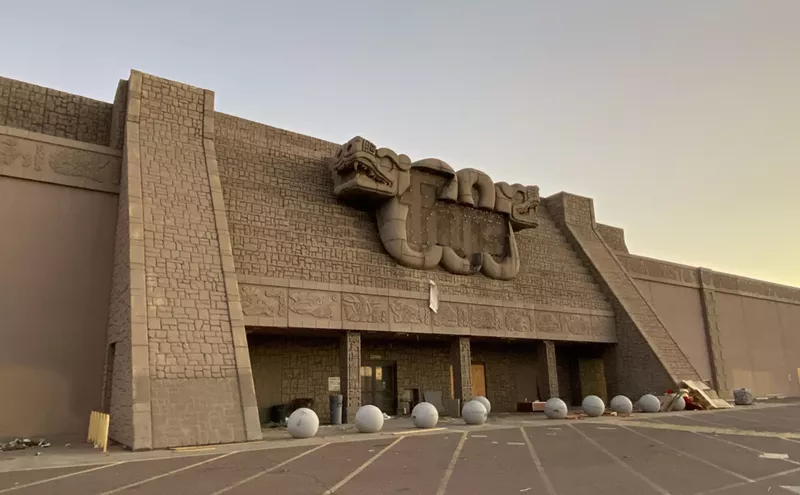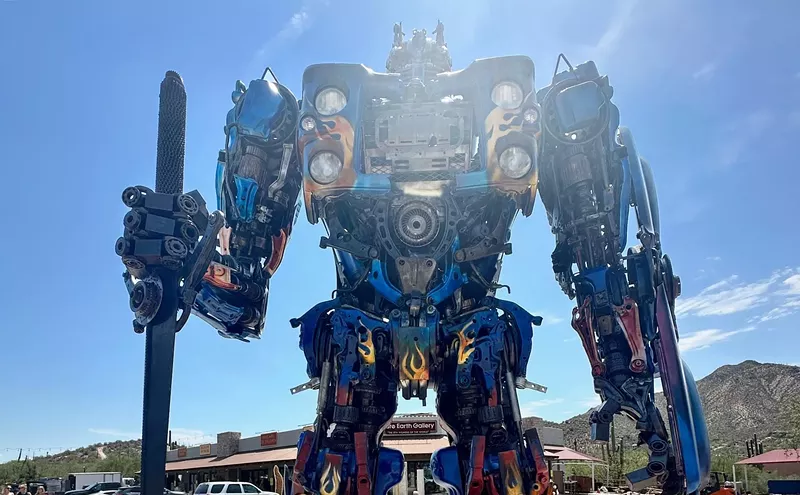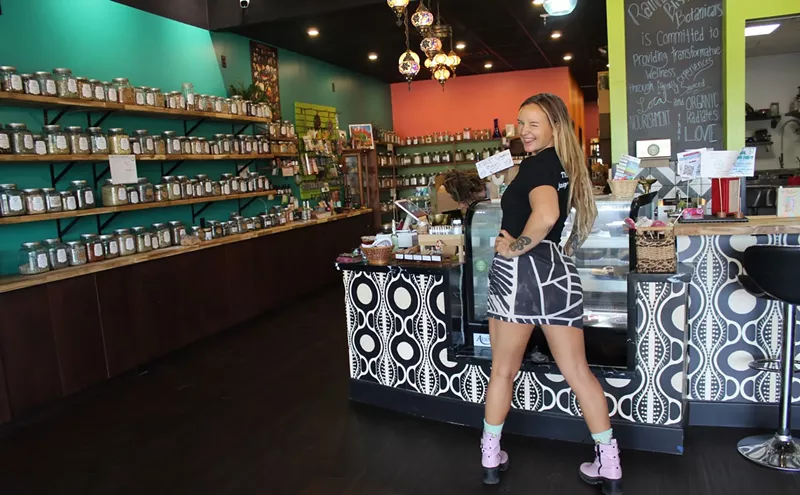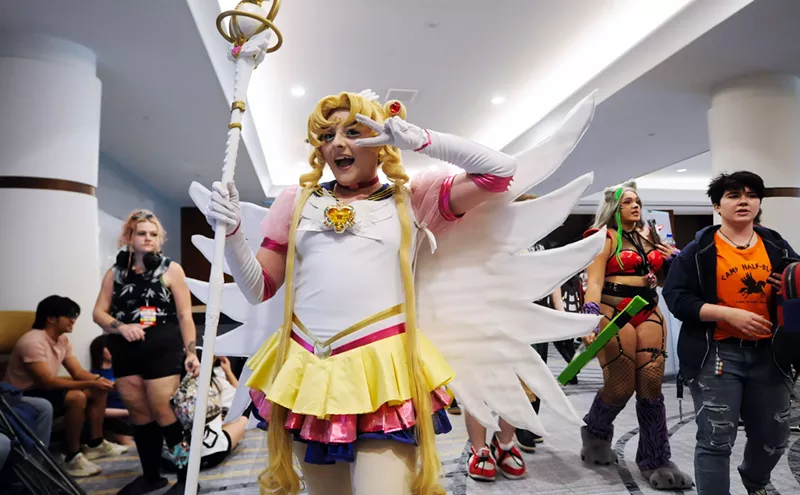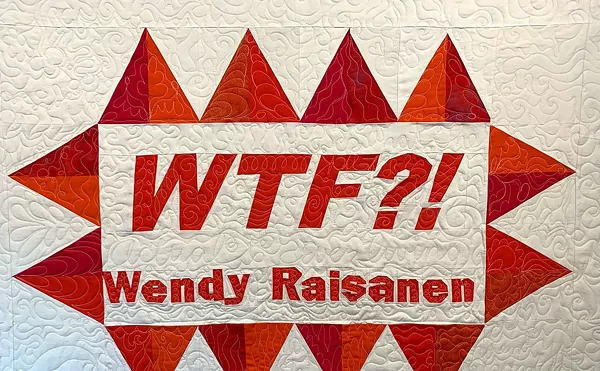In Phoenix the downtown is still more down than town, so you have to invest some elbow grease if you want an urban experience. The city's center is the equivalent of a fixer-upper house: It's cheap, funky, and loaded with potential, but it's going to take some DIY zeal to make it into the high-density, happenin' place of hipster dreams.
Talk to the people who run the tiny galleries, restaurants and retail shops on Grand Avenue and Roosevelt Row, and they can tell you some stories about building a living, breathing urban center from the ground up. It's a process short on glamour and loaded with hard work. These DIY-ers don't spend their days in black turtlenecks talking about the Whitney Biennial. Instead, they're scraping asbestos tile off the floor, juggling bills, and unstopping 60-year-old toilets.
And, generally, they love it.
"This is the only job I can imagine doing," says JRC, who, along with his significant other, Stephanie Carrico, runs the Trunk Space, a wee art space at 15th Avenue and Grand. He has a degree in painting; she has one in fine art photography. But they spend as much as 70 hours a week doing the menial chores it takes to operate a small business. They sweep floors, sell sodas, hang art shows, take art shows down when a band plays the space, rehang the shows when the band is finished, make fliers for upcoming shows, buy paper towels at Costco and do the books.
On a recent weeknight, the local band Dust Jacket was scheduled to play the Trunk Space. One of the band members had car trouble, and the group was nearly two hours late to the gig. JRC, who was busy collecting the door and supervising the, um, housing- and personal-hygiene-challenged man he had hired to direct traffic in the parking lot, coerced the opening act, a singer-songwriter from Alaska, into playing a longer set.
A much longer set. At one point, the poor guy was pulling audience members who also happened to be in other local bands on stage to sing and jam with him.
Finally, the headliner act showed up, and JRC spent the next hour helping them with sound checks. The scene could have been a training film for a course in multitasking. JRC would collect the cover charge from a customer at the front door, run over and consult with the Dust Jacket boys on their amps and mics, run outside to guesstimate how many more cars could squeeze into the overcrowded parking lot, and then return to collect a cover from another patron.
Meanwhile, Carrico sat at a computer behind the refreshment counter, pecking out next month's Trunk Space newsletter in between selling sodas and coffee to patrons who had to work to get her attention because she was wearing earplugs to blot out the din of the music.
The Space doubles as an art gallery, so JRC had come in earlier in the day and taken the 20 or so pieces in the latest exhibition off the walls and packed them into the safety of a back room. When the band finished playing at midnight, he and Carrico rehung the entire show before picking up the beer bottles and cups that littered the space and the parking lot, restocking the snack counter, taking down the sound system and locking up.
Did Lawrence Ferlinghetti work this hard to keep City Lights humming?
A few doors down at Perihelion Arts, owner Amy Young is delighted to have front doors again. An SUV barreled into the combo art gallery and bookstore last December, coming to a stop in the middle of the gallery. No one was injured because the accident happened in the middle of the night, long after the First Friday crowd had gone home. None of the art was harmed, either.
Perihelion's floor glittered with shards of glass from the demolished doors for days after the accident. Still, the show went on. Young nailed sheets of plywood over the gaping hole and tacked a note on them instructing customers to use the back entrance. Like any plucky DIY-er, she was unfazed by the freak accident.
"What are the odds of that ever happening again?" Young asks.
Of course, weirdness happens. It's Grand Avenue, after all.
Over on Roosevelt Row, the scene has started to gentrify in relatively short order. There's the gorgeous and sophisticated monOrchid space that gives a peek into what downtown could be like when its transformation is complete. A block of condos popped up like mushrooms after a rain of developer money, which worries those who prefer their downtown nice and rough. (A recent ad on Craigslist for studio space in a downtown warehouse boasted that the surrounding neighborhood was still authentically tough.) And along with those condos, there's Artisan Lofts, a row of sparkling new retail spaces with second-floor living accommodations for business owners that house the likes of artisan cakemaker Tammie Coe. It's also home to Retail Laboratory, a hip boutique opened by Kurt DeMunbrun and Chris Bale, a couple of guys who wearied of heart-stopping Los Angeles real estate prices and decamped for the tabula rasa of downtown Phoenix.
"When we moved here, we came down for First Fridays and started buying art," says Bale, who grew up in Phoenix and has a degree in photography from Arizona State University. "We were really into what was happening. We said, 'Hey, we can open the store we always wanted to open in L.A. We can do it here.'"
DeMunbrun and Bale have opened a second Retail Laboratory at Biltmore Fashion Park. They've got to pay the bills on Roosevelt, and there's not enough traffic yet through their first store to keep them going, so they're counting on the mall location to float the downtown store through the early, lean times.
Ask DIY-ers why they're in downtown Phoenix, and they cite the very things cultural critics decry about the place: Its emptiness. Its lack of an existing scene.
"We saw all the vacant buildings and parking lots, and we saw incredible potential," Bale says. "In Los Angeles, we would have to fight for attention for our store. Here, we have people come in on bended knee and say, 'Thank you for being here.'"
JRC came to Phoenix from upstate New York. "I moved here specifically to be part of the art community that is here," he says. "We tend toward underground or outsider art, [and] it is really the right place for what we do. It's open here."
When Beatrice Moore -- an artist widely regarded as the doyenne of the inner city because she came downtown when downtown wasn't cool -- was looking for a place to call home way back in 1987 after a two-year stint in Europe, she picked Phoenix precisely because it was uncool.
"We didn't want to be part of a hip art scene," she says. (The "we" refers to her longtime partner, artist Tony Zahn.) "We liked the fact that nothing was happening here."
Ironically, Moore immediately set to work energizing the sleepy non-scene that had attracted her in the first place. A year after moving to town, Moore started Art Detour, an annual event that brings thousands of people downtown to tour artists' studios. A monthly version of the event, First Friday, evolved some time later and continues to this day with help from the nonprofit association ArtLink. Many credit these events as being the catalyst for the downtown renaissance.
Moore also started buying up downtown buildings, and now she owns 13 structures, a total of 30,000 square feet of commercial real estate. She rents to artists and arts-related businesses, and she has her own studio on Grand Avenue. Moore and Zahn are regarded as royalty on the downtown scene, partly because they were down there first and partly because they are landlords to around 25 artists and arts-related businesspeople.
But guess what? King Tony and Queen Bea are working their heinies off, too. Moore and Zahn do their own maintenance, because when you're charging 55 cents to 75 cents a square foot for their property, you can't afford a super.
"For people to make it in a business, they have to multitask. We maintain all the swamp coolers. We unplug the toilets," Moore says. "I clean the toilets for First Fridays in places where there's a hall bathroom. I deal with tenants and do tile work in bathrooms. Tony just did the trenching for the plumbing and electrical [at a building they're rehabbing]. He is cutting out cement floors, taking out walls. He repaired the roof before it was refoamed."
Nobody's getting rich. Most declined to discuss specifics about their finances, but all said their margins were thinner than Nicole Richie's thighs. "Trunk Space is self-sustaining," JRC says. "We've had plenty of lean months. We've learned to be good jugglers. I've learned a lot about what I can live without: air conditioning in the car, fancy meals, vacations. But we don't worry about money anymore. Maybe we've gotten used to [struggling]."
Like many downtown artists, Hector Ruiz doesn't have air conditioning in his Grand Avenue gallery and studio, Chocolate Factory, which makes summer art openings in the converted auto garage akin to a Navajo sweat lodge.
Downtown Phoenix's rawness doesn't just give artists a lesson in using power tools. Many say the blankness of the place is liberating, and that it frees their creativity and opens their minds in a way that might not happen in a more established city.
"This is such an interesting area right now," says Matt Moore, an artist who draws tract house floor plans in west Phoenix alfalfa fields with a tractor. He shares a studio with wife and fellow artist Carrie Marill in one of Beatrice Moore's buildings on Grand Avenue. "There's all this attention paid to this new city, to what it's going to be like in 15 years. As an artist, it's interesting to be around a place that's growing through those questions."
With the emptiness comes freedom, too. In a nascent arts district, failures are forgiven. Artists and gallery owners say that makes them more willing to take risks, which is key to creativity.
"We're able to live down our mistakes: shows that didn't go well, art openings that didn't get the attention they should've," JRC says.
"I would be a crappy artist if I lived somewhere else," Matt Moore says. "I felt freer to try new things here than I would have if I had been in New York."
Still, naysayers snort about the downtown scene. "Poseurs!" they sneer. "Dilettantes who are more interested in making the scene than making art!" they gripe.
But the DIY-ers insist that's not so, that there is a here, here.
"There's a lot going on here. It's just a lot more fragmented than in other places," Beatrice Moore says.
JRC says the critics need to spend more time downtown. "We're not trying to be cool. We're not trying to be anything, we're just doing something we love and think is important," he says. "To say we're being poseurs implies we're trying to be like someplace else. I think downtown [Phoenix] is really developing its own identity."
Ret Lab's Bale believes downtown Phoenix will shake off its dust and explode. It's just a matter of time. "From living in L.A. and watching neighborhoods getting discovered, I know that in five years, people are going to look at downtown Phoenix and go, 'What happened?!'" he says. "Phoenix is a great city. I'm happy to be part of what's happening here."



